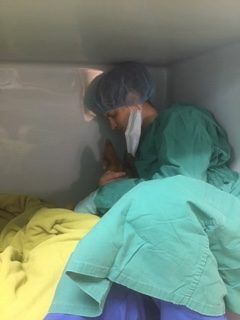
Pet owners are often very anxious about veterinary procedures that involve anesthesia. Our hospital makes sure your pet is very safe during any anesthesia procedure.
Prior to any anesthetic procedure our hospital requires a pre-surgical exam and bloodwork to be performed within 30 days of the procedure. The purpose of this bloodwork is to ensure your pet doesn’t have anything unknown wrong with them prior to the procedure and to make sure they’re truly healthy. See the hand out below to better understand the importance of bloodwork.
All anesthesia patients are weighed on admission and then undergo a thorough pre-anesthetic examination, which includes an examination of the chest, palpation of the abdomen, and assessment of the gums. The doctor will provide any pre-operation medications and pre-anesthetic sedation medications. A protocol is determined based on your pets personal needs to keep them as safe and comfortably sedate during the procedure. In order to ensure accurate delivery of the gas anesthetic, a breathing tube, called an endotracheal tube, is inserted into the trachea. In addition to delivering the gas to the lungs, the endotracheal tube seals off the airway so that fluids cannot be accidentally aspirated while the patient is unconscious and unable to swallow.
Anesthetic monitoring in a veterinary hospital is similar to that found in any human hospital. Your pet will have an IV catheter placed to provide IV fluids during the procedure. The veterinary technician closely monitors your pet while the doctor performs the surgical procedure. The technician uses a pulse oximeter to monitor the pets oxygenation and pulse, Electrocardiogram (ECG) to monitor the heart rate and heart rhythm, a thermometer to monitor temperature, and a blood pressure monitor. While these electronic methods of monitoring anesthesia are very helpful, our technicians are well trained in hands on monitoring; checking their anesthetic depths, checking heart rates, check respiratory rate, and recording all of the pets vitals every 5 minutes. At the first sign of any concern, the doctor is immediately notified and determines the healthiest way to proceed for your pets safety.
Your pet will recover at the hospital for most of the day, so that our veterinarian can make sure your pet is safe to go home. Your pet will be groggy for 24-48 hours, but will return to normal once the anesthesia wears off. A pet heals from most procedures within 12-14 days.
